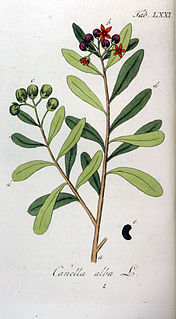
The Cucurbitaceae, also called cucurbits and the gourd family, are a plant family consisting of about 965 species in around 95 genera, the most important of which are:
Phelline is a genus of shrubs and the sole member of the family Phellinaceae, one of the three families of flowering plants that are endemic to New Caledonia. It is placed in the order Asterales and is related to two other small plant families: Alseuosmiaceae and Argophyllaceae. It contains ten species.
Lobanilia is a plant genus of the family Euphorbiaceae and the sole genus of the subtribe Lobaniliinae. It was first described as a genus in 1989 and is endemic to Madagascar.
- Lobanilia asterothrixRadcl.-Sm.
- Lobanilia bakeriana(Baill.) Radcl.-Sm.
- Lobanilia claoxyloidesRadcl.-Sm.
- Lobanilia crotonoidesRadcl.-Sm.
- Lobanilia hirtella(Baill.) Radcl.-Sm.
- Lobanilia luteobrunnea(Baker) Radcl.-Sm.
- Lobanilia ovalis(Baill.) Radcl.-Sm.
Orfilea is a plant genus of the family Euphorbiaceae first described as a genus in 1858. It is native to Madagascar and other islands in the Indian Ocean.
- Orfilea ankafinensis(Baill.) Radcl.-Sm. & Govaerts - W Madagascar
- Orfilea coriaceaBaill. - Comoros, Madagascar
- Orfilea multispicata(Baill.) G.L.Webster - Madagascar
- Orfilea neraudiana(Baill.) G.L.Webster - Mauritius
Alphandia is a plant genus of the family Euphorbiaceae first described as a genus in 1873. It is native to certain islands in the western Pacific.
- Alphandia furfuraceaBaill. - New Caledonia, Aneityum
- Alphandia resinosaBaill. - Art Island in New Caledonia
- Alphandia verniciflua Airy Shaw - West New Guinea
Cocconerion is a genus of plants under the family Euphorbiaceae first described as a genus in 1873. The entire genus is endemic to New Caledonia and is related to Baloghia.
- Cocconerion balansae Baill. - SE New Caledonia
- Cocconerion minus Baill. - New Caledonia, Loyalty Islands
Dalembertia is a plant genus of the family Euphorbiaceae first described as a genus in 1858. It is native to Mexico and Guatemala.
- Dalembertia hahnianaBaill. - México State, Morelos, Michoacán
- Dalembertia platanoidesBaill. - Oaxaca, Guerrero, México State
- Dalembertia populifoliaBaill. - from Sonora to Oaxaca
- Dalembertia triangularisMüll.Arg. - Guatemala, Chiapas, Oaxaca
Dissiliaria is a genus of plants under the family Picrodendraceae described as a genus in 1867.

Henri Ernest Baillon was a French botanist and physician. He was born in Calais on November 30, 1827 and died in Paris on July 19, 1895.

Sarcococca is a genus of 11 species of flowering plants in the box family Buxaceae, native to eastern and southeastern Asia and the Himalayas. They are slow-growing, monoecious, evergreen shrubs 1–2 m (3–7 ft) tall. The leaves are borne alternately, 3–12 cm long and 1–4 cm broad. They bear fragrant flowers, often in winter. The fruit is a red or black drupe containing 1–3 seeds. Some species are cultivated as groundcover or low hedging in moist, shady areas. The basic chromosome number for genus is 14.

Myrothamnus is a genus of flowering plants, consisting of two species of small xerophytic shrubs, in the southern parts of tropical Africa and in Madagascar. Myrothamnus is recognized as the only genus in the family Myrothamnaceae.

Stereospermum is a genus of trees in the paleotropical clade of the family Bignoniaceae. A species of Stereospermum is used in herbal medicine in ayurveda as well as it is an integral part of the culture and tradition of the cold desert biosphere reserve.

Dombeya is a flowering plant genus. Traditionally included in the family Sterculiaceae, it is included in the expanded Malvaceae in the APG and most subsequent systematics. These plants are known by a number of vernacular names which sometimes, misleadingly, allude to the superficial similarity of flowering Dombeya to pears or hydrangeas. Therefore, the genus as a whole is often simply called dombeyas. The generic name commemorates Joseph Dombey (1742–1794), a French botanist and explorer in South America, involved in the notorious Dombey affair, embroiling scientists and governments of France, Spain, and Britain for more than two years.

Carphalea is a genus of flowering plants in the Rubiaceae family. It is endemic to Madagascar.

Parsonsia is a genus of woody vines of the dogbane family, Apocynaceae. Species occur throughout Indomalaya, Australasia and Melanesia.
Griffonia is a genus of flowering plants in the legume family, Fabaceae. It belongs to the subfamily Cercidoideae. Griffonia is known to have a high concentration of 5-HTP in its seeds.

Uncarina is a genus of plant in the family Pedaliaceae found in Madagascar.

Crateva is a genus of flowering plants in the caper family, Capparaceae.
Elaeoluma is a genus of plants in the family Sapotaceae described as a genus in 1891.
Stixis is a South-East Asian genus of plants in the order Brassicales; they are typically lianas. This genus has previously been placed in the Stixaceae and Capparaceae, but under the APG IV system is now included in the family Resedaceae.












